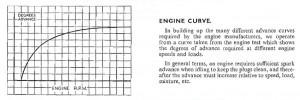Note: all data in this overview are given in crank degrees and crank rpm.
The following information has been gathered from various sources (both Jaguar and Lucas), but the available information is at times unclear or confusing. Therefore the data should be regarded as “additional help” and not as the ”absolute truth”.
Jaguar used Lucas distributors for the engine of the XK 120, 140 and 150 (and of course for the Saloons of that era). For this overview to types of distributors are of interest:
- DVX(H)6A distributors for XK120 and XK140.
- DMBZ6A distributors for XK150.
Note the different lower aluminium housing of the DVX(H)6A (left) in comparison to the DMBZ6A distributor (right).
The difference between the distributors for the (early) XK 120 and 140 is mainly in the cap with horizontal spark plug cables for the XK 120 (up to 1953, recognisable in the letter H in DVXH6A) whereas later XK 120 and 140 distributors had vertical spark plug cables. A good example of that difference is the Lucas 40199 distributor which was used both in the XK 120 and 140: the XK 120 used the 40199A to D with type indication DVXH6A and the XK 140 had the 40199E with type indication DVX6A. The only real difference between the two being the distributor cap: 415708 for the XK 120 and 407043 for the XK 140. The XK 150 distributors of the DMBZ6A type are totally different from the DVX(H)6A types .
The surveys below also mention an E.C.M. curve which in fact describes the ignition advance from idle to maximum allowed r.p.m. as indicated by the manufacturer. There is a lot of discussion about the meaning of the term ECM as Lucas used in all of their ignition data.
In the Lucas “Overseas Technical Correspondence Course” Section 3 “Coil Ignition” Part 2 the following is explained:
Engine Curve: “In building up the many different advance curves required by the engine manufacturers, we operate from a curve taken from the engine test which shows the degrees of advance required at different engine speeds and loads.”
We may assume from this that Lucas was confronted with many different Engine Curve Models (ECM) and started to build up a “library of ECM’s” giving them specific numbers.
Ignition data for XK 120 engines
Ignition data for XK 140 engines
Ignition data for XK 150 engines





